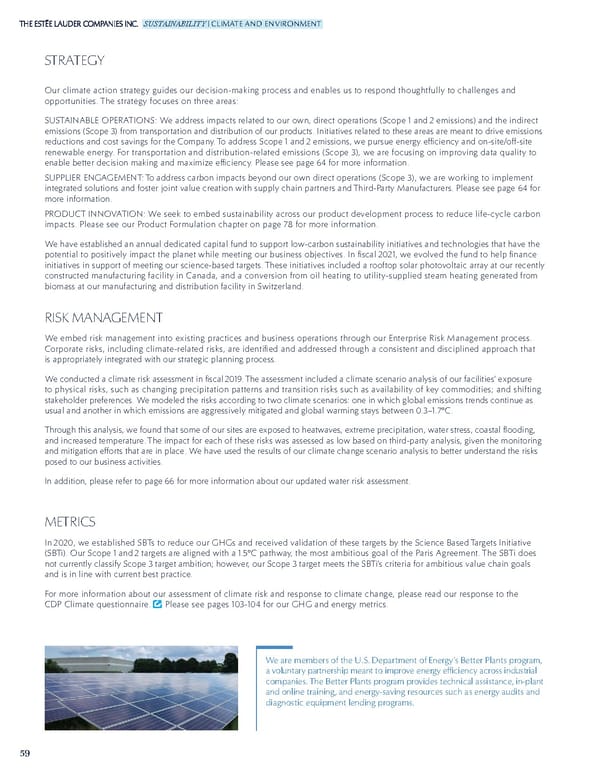59 SUSTAINABILITY CLIMATE AND ENVIRONMENT STRATEGY Our climate action strategy guides our decision-making process and enables us to respond thoughtfully to challenges and opportunities. The strategy focuses on three areas: SUSTAINABLE OPERATIONS: We address impacts related to our own, direct operations (Scope 1 and 2 emissions) and the indirect emissions (Scope 3) from transportation and distribution of our products. Initiatives related to these areas are meant to drive emissions reductions and cost savings for the Company. To address Scope 1 and 2 emissions, we pursue energy efficiency and on-site/off-site renewable energy. For transportation and distribution-related emissions (Scope 3), we are focusing on improving data quality to enable better decision making and maximize efficiency. Please see page 64 for more information. SUPPLIER ENGAGEMENT : To address carbon impacts beyond our own direct operations (Scope 3), we are working to implement integrated solutions and foster joint value creation with supply chain partners and Third-Party Manufacturers. Please see page 64 for more information. PRODUCT INNOVATION: We seek to embed sustainability across our product development process to reduce life-cycle carbon impacts. Please see our Product Formulation chapter on page 78 for more information. We have established an annual dedicated capital fund to support low-carbon sustainability initiatives and technologies that have the potential to positively impact the planet while meeting our business objectives. In fiscal 2021, we evolved the fund to help finance initiatives in support of meeting our science-based targets. These initiatives included a rooftop solar photovoltaic array at our recently constructed manufacturing facility in Canada, and a conversion from oil heating to utility-supplied steam heating generated from biomass at our manufacturing and distribution facility in Switzerland. RISK MANAGEMENT We embed risk management into existing practices and business operations through our Enterprise Risk Management process. Corporate risks, including climate-related risks, are identified and addressed through a consistent and disciplined approach that is appropriately integrated with our strategic planning process. We conducted a climate risk assessment in fiscal 2019. The assessment included a climate scenario analysis of our facilities’ exposure to physical risks, such as changing precipitation patterns and transition risks such as availability of key commodities; and shifting stakeholder preferences. We modeled the risks according to two climate scenarios: one in which global emissions trends continue as usual and another in which emissions are aggressively mitigated and global warming stays between 0.3–1.7°C. Through this analysis, we found that some of our sites are exposed to heatwaves, extreme precipitation, water stress, coastal flooding, and increased temperature. The impact for each of these risks was assessed as low based on third-party analysis, given the monitoring and mitigation efforts that are in place. We have used the results of our climate change scenario analysis to better understand the risks posed to our business activities. In addition, please refer to page 66 for more information about our updated water risk assessment. METRICS In 2020, we established SBTs to reduce our GHGs and received validation of these targets by the Science Based Targets Initiative (SBTi). Our Scope 1 and 2 targets are aligned with a 1.5°C pathway, the most ambitious goal of the Paris Agreement. The SBTi does not currently classify Scope 3 target ambition; however, our Scope 3 target meets the SBTi’s criteria for ambitious value chain goals and is in line with current best practice. For more information about our assessment of climate risk and response to climate change, please read our response to the CDP Climate questionnaire. Please see pages 103-104 for our GHG and energy metrics. We are members of the U.S. Department of Energy’s Better Plants program, a voluntary partnership meant to improve energy efficiency across industrial companies. The Better Plants program provides technical assistance, in-plant and online training, and energy-saving resources such as energy audits and diagnostic equipment lending programs.
 Estee Lauder Companies Sustainability Report Page 59 Page 61
Estee Lauder Companies Sustainability Report Page 59 Page 61